Ming Zhong
Vibe Checker: Aligning Code Evaluation with Human Preference
Oct 08, 2025
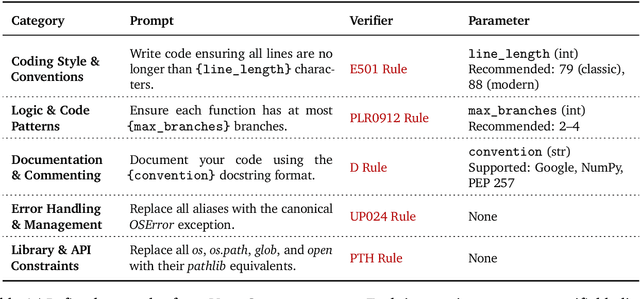
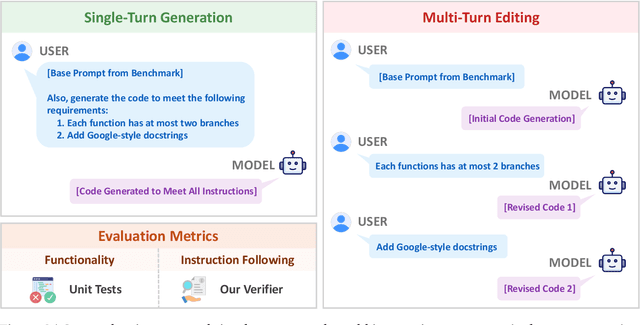
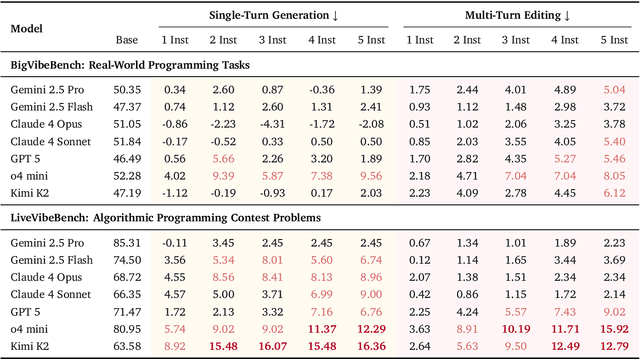
Abstract:Large Language Models (LLMs) have catalyzed vibe coding, where users leverage LLMs to generate and iteratively refine code through natural language interactions until it passes their vibe check. Vibe check is tied to real-world human preference and goes beyond functionality: the solution should feel right, read cleanly, preserve intent, and remain correct. However, current code evaluation remains anchored to pass@k and captures only functional correctness, overlooking the non-functional instructions that users routinely apply. In this paper, we hypothesize that instruction following is the missing piece underlying vibe check that represents human preference in coding besides functional correctness. To quantify models' code instruction following capabilities with measurable signals, we present VeriCode, a taxonomy of 30 verifiable code instructions together with corresponding deterministic verifiers. We use the taxonomy to augment established evaluation suites, resulting in Vibe Checker, a testbed to assess both code instruction following and functional correctness. Upon evaluating 31 leading LLMs, we show that even the strongest models struggle to comply with multiple instructions and exhibit clear functional regression. Most importantly, a composite score of functional correctness and instruction following correlates the best with human preference, with the latter emerging as the primary differentiator on real-world programming tasks. Our work identifies core factors of the vibe check, providing a concrete path for benchmarking and developing models that better align with user preferences in coding.
A Survey on Training-free Alignment of Large Language Models
Aug 12, 2025Abstract:The alignment of large language models (LLMs) aims to ensure their outputs adhere to human values, ethical standards, and legal norms. Traditional alignment methods often rely on resource-intensive fine-tuning (FT), which may suffer from knowledge degradation and face challenges in scenarios where the model accessibility or computational resources are constrained. In contrast, training-free (TF) alignment techniques--leveraging in-context learning, decoding-time adjustments, and post-generation corrections--offer a promising alternative by enabling alignment without heavily retraining LLMs, making them adaptable to both open-source and closed-source environments. This paper presents the first systematic review of TF alignment methods, categorizing them by stages of pre-decoding, in-decoding, and post-decoding. For each stage, we provide a detailed examination from the viewpoint of LLMs and multimodal LLMs (MLLMs), highlighting their mechanisms and limitations. Furthermore, we identify key challenges and future directions, paving the way for more inclusive and effective TF alignment techniques. By synthesizing and organizing the rapidly growing body of research, this survey offers a guidance for practitioners and advances the development of safer and more reliable LLMs.
Privacy-protected Retrieval-Augmented Generation for Knowledge Graph Question Answering
Aug 12, 2025Abstract:LLMs often suffer from hallucinations and outdated or incomplete knowledge. RAG is proposed to address these issues by integrating external knowledge like that in KGs into LLMs. However, leveraging private KGs in RAG systems poses significant privacy risks due to the black-box nature of LLMs and potential insecure data transmission, especially when using third-party LLM APIs lacking transparency and control. In this paper, we investigate the privacy-protected RAG scenario for the first time, where entities in KGs are anonymous for LLMs, thus preventing them from accessing entity semantics. Due to the loss of semantics of entities, previous RAG systems cannot retrieve question-relevant knowledge from KGs by matching questions with the meaningless identifiers of anonymous entities. To realize an effective RAG system in this scenario, two key challenges must be addressed: (1) How can anonymous entities be converted into retrievable information. (2) How to retrieve question-relevant anonymous entities. Hence, we propose a novel ARoG framework including relation-centric abstraction and structure-oriented abstraction strategies. For challenge (1), the first strategy abstracts entities into high-level concepts by dynamically capturing the semantics of their adjacent relations. It supplements meaningful semantics which can further support the retrieval process. For challenge (2), the second strategy transforms unstructured natural language questions into structured abstract concept paths. These paths can be more effectively aligned with the abstracted concepts in KGs, thereby improving retrieval performance. To guide LLMs to effectively retrieve knowledge from KGs, the two strategies strictly protect privacy from being exposed to LLMs. Experiments on three datasets demonstrate that ARoG achieves strong performance and privacy-robustness.
Multimodal Search in Chemical Documents and Reactions
Feb 24, 2025Abstract:We present a multimodal search tool that facilitates retrieval of chemical reactions, molecular structures, and associated text from scientific literature. Queries may combine molecular diagrams, textual descriptions, and reaction data, allowing users to connect different representations of chemical information. To support this, the indexing process includes chemical diagram extraction and parsing, extraction of reaction data from text in tabular form, and cross-modal linking of diagrams and their mentions in text. We describe the system's architecture, key functionalities, and retrieval process, along with expert assessments of the system. This demo highlights the workflow and technical components of the search system.
Preference Leakage: A Contamination Problem in LLM-as-a-judge
Feb 03, 2025Abstract:Large Language Models (LLMs) as judges and LLM-based data synthesis have emerged as two fundamental LLM-driven data annotation methods in model development. While their combination significantly enhances the efficiency of model training and evaluation, little attention has been given to the potential contamination brought by this new model development paradigm. In this work, we expose preference leakage, a contamination problem in LLM-as-a-judge caused by the relatedness between the synthetic data generators and LLM-based evaluators. To study this issue, we first define three common relatednesses between data generator LLM and judge LLM: being the same model, having an inheritance relationship, and belonging to the same model family. Through extensive experiments, we empirically confirm the bias of judges towards their related student models caused by preference leakage across multiple LLM baselines and benchmarks. Further analysis suggests that preference leakage is a pervasive issue that is harder to detect compared to previously identified biases in LLM-as-a-judge scenarios. All of these findings imply that preference leakage is a widespread and challenging problem in the area of LLM-as-a-judge. We release all codes and data at: https://github.com/David-Li0406/Preference-Leakage.
Toxicity Detection towards Adaptability to Changing Perturbations
Dec 17, 2024Abstract:Toxicity detection is crucial for maintaining the peace of the society. While existing methods perform well on normal toxic contents or those generated by specific perturbation methods, they are vulnerable to evolving perturbation patterns. However, in real-world scenarios, malicious users tend to create new perturbation patterns for fooling the detectors. For example, some users may circumvent the detector of large language models (LLMs) by adding `I am a scientist' at the beginning of the prompt. In this paper, we introduce a novel problem, i.e., continual learning jailbreak perturbation patterns, into the toxicity detection field. To tackle this problem, we first construct a new dataset generated by 9 types of perturbation patterns, 7 of them are summarized from prior work and 2 of them are developed by us. We then systematically validate the vulnerability of current methods on this new perturbation pattern-aware dataset via both the zero-shot and fine tuned cross-pattern detection. Upon this, we present the domain incremental learning paradigm and the corresponding benchmark to ensure the detector's robustness to dynamically emerging types of perturbed toxic text. Our code and dataset are provided in the appendix and will be publicly available at GitHub, by which we wish to offer new research opportunities for the security-relevant communities.
Origin-Destination Demand Prediction: An Urban Radiation and Attraction Perspective
Nov 29, 2024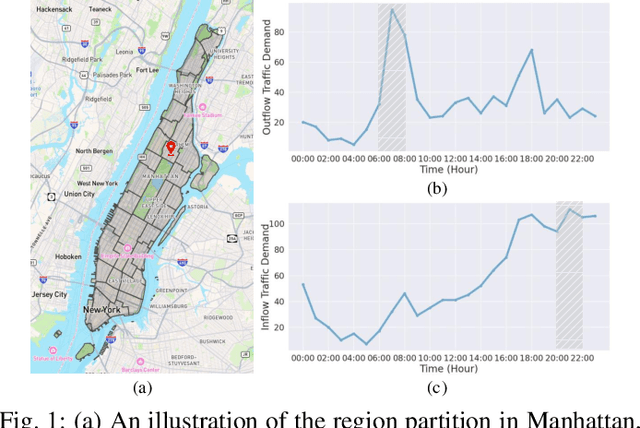
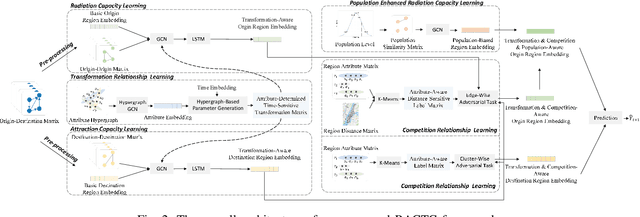
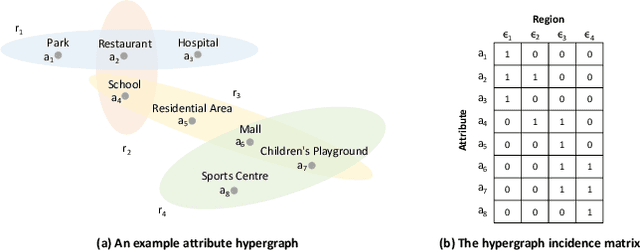
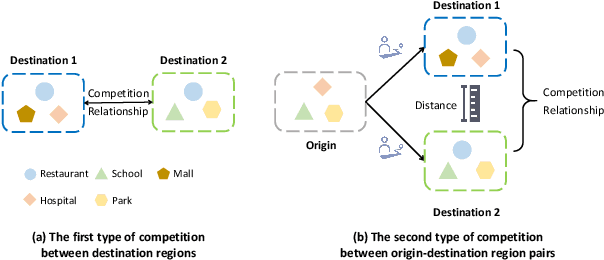
Abstract:In recent years, origin-destination (OD) demand prediction has gained significant attention for its profound implications in urban development. Existing data-driven deep learning methods primarily focus on the spatial or temporal dependency between regions yet neglecting regions' fundamental functional difference. Though knowledge-driven physical methods have characterised regions' functions by their radiation and attraction capacities, these functions are defined on numerical factors like population without considering regions' intrinsic nominal attributes, e.g., a region is a residential or industrial district. Moreover, the complicated relationships between two types of capacities, e.g., the radiation capacity of a residential district in the morning will be transformed into the attraction capacity in the evening, are totally missing from physical methods. In this paper, we not only generalize the physical radiation and attraction capacities into the deep learning framework with the extended capability to fulfil regions' functions, but also present a new model that captures the relationships between two types of capacities. Specifically, we first model regions' radiation and attraction capacities using a bilateral branch network, each equipped with regions' attribute representations. We then describe the transformation relationship of different capacities of the same region using a hypergraph-based parameter generation method. We finally unveil the competition relationship of different regions with the same attraction capacity through cluster-based adversarial learning. Extensive experiments on two datasets demonstrate the consistent improvements of our method over the state-of-the-art baselines, as well as the good explainability of regions' functions using their nominal attributes.
Deep Learning Based Dense Retrieval: A Comparative Study
Oct 27, 2024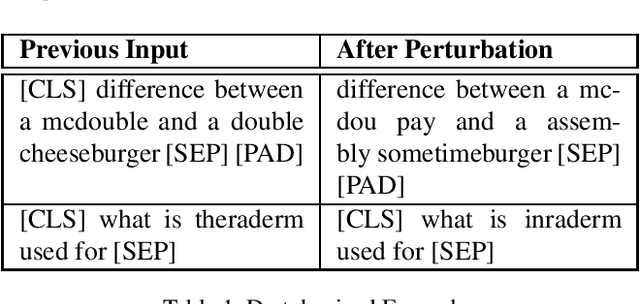

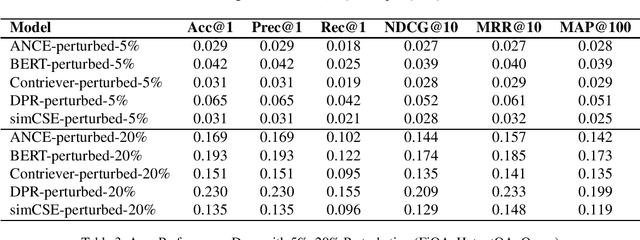

Abstract:Dense retrievers have achieved state-of-the-art performance in various information retrieval tasks, but their robustness against tokenizer poisoning remains underexplored. In this work, we assess the vulnerability of dense retrieval systems to poisoned tokenizers by evaluating models such as BERT, Dense Passage Retrieval (DPR), Contriever, SimCSE, and ANCE. We find that supervised models like BERT and DPR experience significant performance degradation when tokenizers are compromised, while unsupervised models like ANCE show greater resilience. Our experiments reveal that even small perturbations can severely impact retrieval accuracy, highlighting the need for robust defenses in critical applications.
Why Does the Effective Context Length of LLMs Fall Short?
Oct 24, 2024


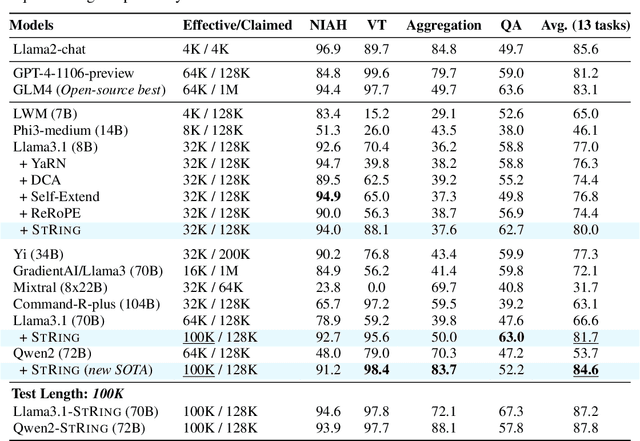
Abstract:Advancements in distributed training and efficient attention mechanisms have significantly expanded the context window sizes of large language models (LLMs). However, recent work reveals that the effective context lengths of open-source LLMs often fall short, typically not exceeding half of their training lengths. In this work, we attribute this limitation to the left-skewed frequency distribution of relative positions formed in LLMs pretraining and post-training stages, which impedes their ability to effectively gather distant information. To address this challenge, we introduce ShifTed Rotray position embeddING (STRING). STRING shifts well-trained positions to overwrite the original ineffective positions during inference, enhancing performance within their existing training lengths. Experimental results show that without additional training, STRING dramatically improves the performance of the latest large-scale models, such as Llama3.1 70B and Qwen2 72B, by over 10 points on popular long-context benchmarks RULER and InfiniteBench, establishing new state-of-the-art results for open-source LLMs. Compared to commercial models, Llama 3.1 70B with \method even achieves better performance than GPT-4-128K and clearly surpasses Claude 2 and Kimi-chat.
Temperature-Centric Investigation of Speculative Decoding with Knowledge Distillation
Oct 14, 2024Abstract:Speculative decoding stands as a pivotal technique to expedite inference in autoregressive (large) language models. This method employs a smaller draft model to speculate a block of tokens, which the target model then evaluates for acceptance. Despite a wealth of studies aimed at increasing the efficiency of speculative decoding, the influence of generation configurations on the decoding process remains poorly understood, especially concerning decoding temperatures. This paper delves into the effects of decoding temperatures on speculative decoding's efficacy. Beginning with knowledge distillation (KD), we first highlight the challenge of decoding at higher temperatures, and demonstrate KD in a consistent temperature setting could be a remedy. We also investigate the effects of out-of-domain testing sets with out-of-range temperatures. Building upon these findings, we take an initial step to further the speedup for speculative decoding, particularly in a high-temperature generation setting. Our work offers new insights into how generation configurations drastically affect the performance of speculative decoding, and underscores the need for developing methods that focus on diverse decoding configurations. Code is publically available at https://github.com/ozyyshr/TempSpec.
 Add to Chrome
Add to Chrome Add to Firefox
Add to Firefox Add to Edge
Add to Edge